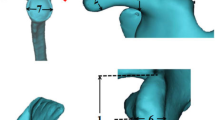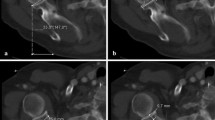Abstract
Purpose
In the literature, there are several techniques for measuring the glenoidal version of the scapula. The superiority of the scannographic measurement over the standard radiologic measures seems evident. The main problems are the evaluation and the reproducibility of these methods, which are dependent on the quality of the CT scan and the orientation of its sections. We pinpoint a simple method of the “scapular triangle”, the reliability of which deserves special consideration. The aim of this study is to report a simple and reproducible computed tomography method to measure the glenoidal version.
Methods
Thrity-one shoulder CT scans, performed on patients attending the emergency department of the University Hospital of Dijon between January 2012 and April 2013 for shoulder trauma, were evaluated retrospectively. The CT scan must include the entire body of scapula to allow measurements to be made with both methods: the conventional method of Friedman and our new method of the “scapular triangle”. Two independent operators performed inter-observer and intra-observer reproducibility. We compared both techniques with Pearson’s test.
Result
Pearson's test showed a trend line according to a linear correlation between the two methods with a p value of 7.791−10 and a correlation coefficient of 0.85 with the 95 % confidence interval (0.7213; 0.929).
Conclusion
The method of the “scapular triangle” is easily applicable on most sections of the CT scan of scapula whether or not it takes the whole body. It is more reliable and reproducible and could be used by any radiologist.







Similar content being viewed by others
References
Nyffeler RW, Jost B, Pfirrmann CW, Gerber C (2003) Measurement of glenoid version: conventional radiographs versus computed tomography scans. J Shoulder Elbow Surg 12(5):493–496
Friedman RJ, Hawthorne KB, Genez BM (1992) The use of computerized tomography in the measurement of glenoid version. J Bone Joint Surg Am 74(7):1032–1037
Rouleau DM, Kidder JF, Pons-Villanueva J, Dynamidis S, Defranco M, Walch G (2010) Glenoid version: how to measure it? Validity of different methods in two-dimensional computed tomography scans. J Shoulder Elbow Surg 19(8):1230–1237
Bokor DJ, O'Sullivan MD, Hazan GJ (1999) Variability of measurement of glenoid version on computed tomography scan. J Shoulder Elbow Surg 8(6):595–598
Matsumura N, Ogawa K, Ikegami H, Collin P, Walch G, Toyama Y (2014) Computed tomography measurement of glenoid vault version as an alternative measuring method for glenoid version. J Orthop Surg Res 9(1):17
Craik JD, Mallina R, Ramasamy V, Little NJ (2014) Human evolution and tears of the rotator cuff. Int Orthop 38(3):547–552
Melean P, Lichtenberg S, Montoya F, Riedmann S, Magosch P, Habermeyer P (2013) The acromial index is not predictive for failed rotator cuff repair. Int Orthop 37(11):2173–2179
Dogan M, Cay N, Tosun O, Karaoglanoglu M, Bozkurt M (2012) Glenoid axis is not related with rotator cuff tears--a magnetic resonance imaging comparative study. Int Orthop 36(3):595–598
Tetreault P, Krueger A, Zurakowski D, Gerber C (2004) Glenoid version and rotator cuff tears. J Orthop Res 22:202–207
Conflict of interest
None.
Author information
Authors and Affiliations
Corresponding author
Rights and permissions
About this article
Cite this article
Andrin, J., Macaron, C., Pottecher, P. et al. Determination of a new computed tomography method for measuring the glenoid version and comparing with a reference method. Radio-anatomical and retrospective study. International Orthopaedics (SICOT) 40, 525–529 (2016). https://doi.org/10.1007/s00264-015-2867-7
Received:
Accepted:
Published:
Issue Date:
DOI: https://doi.org/10.1007/s00264-015-2867-7




